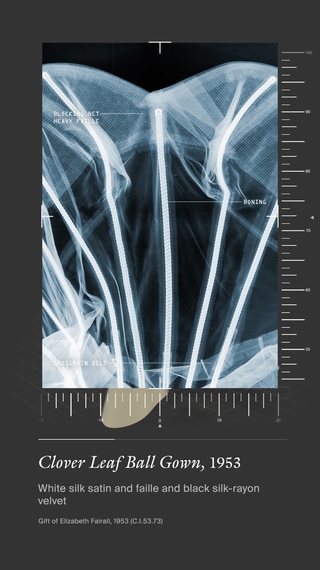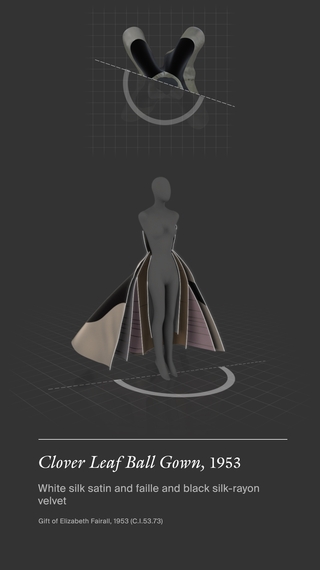Charles James: Beyond Fashion is on view at The Metropolitan Museum of Art through August 10, 2014. Special events will take place at the exhibit 6/12, 6/22, 7/18, and 7/26.
Before architect Ludwig Mies van der Rohe defined high-rise Modernism for the 20th century with his design for Seagram's headquarters on Park Avenue, decades before that, Mies organized exhibits. In 1927 Mies and his collaborator Lilly Reich directed Wiessenhofsiedlung, a major exhibit sponsored by German industry, which included 21 houses and apartment buildings constructed in only five months. But before even that, Mies organized and contributed to exhibits with painters, sculptors, and other artists -- from presentations at the Salon d'Automne in Paris to the architecture-focused Zehrner-Ring collective that formed itself in Mies' office in 1924. Mies organized the architectural component of the first Novemburgruppe exhibitions in Berlin in 1919.
Exhibitions were crucial to early presentations of architectural Modernism, before material technology could catch up to the ideas at play (Beatrice Colomina has great books and lectures on this). Yet, the history of Mies' involvement in the Novemburgruppe and the Zehner-Ring is vastly overshadowed by his later accomplishments in building -- not to mention his invention of the dictum Less is More. According even to Wikipedia, the Zehner-Ring collective headquartered at Mies' office from 1924 to 1926 didn't produce any "results worth mentioning." Considering that Mies designed the Barcelona Pavillion only five years after the founding of Zehrner-Ring, one should probably do very well as an architect to have some results not worth mentioning.
Judging by the limited architectural press devoted to the Diller Scofidio + Renfro (DS+R) genre-busting exhibition design for Charles James: Beyond Fashion at The Metropolitan Museum of Art's Costume Institute, one might almost suspect that DS+R, too, has produced something "not worth mentioning." Inaugurating the Anna Wintour Costume Center, this retrospective of British-American couturier Charles James features exhibit designers DS+R as very visible collaborators. Working with exhibition curators Harold Koda and Jan Glier Reeder, DS+R has seamlessly integrated a number of their own long-held research interests -- in visual technologies, robotics, x-rays and fabric studies -- into the presentation of James' extensive body of work.
Perhaps we are so accustomed to hearing architect's present their designs as inspired by clothing -- whether the drape of a veil in Abu Dhabi or the flair of a skirt in Prague -- that we do not consider the intersection of architectural output and costuming to be newsworthy. The two modes of design have been related for sometime. What is amazing about the DSR work on the Charles James exhibit, however, is something closer to the fundamentals of (architectural) design -- drawings and execution, sequencing, analysis of materiality and the presentation of both methods and effects.
The exhibit is full of animations, drawings that sequence the cutting of the fabric through various stages of draping, connecting, and structuring to form Charles James' haute couture gowns. In front of the clothing artifact, DS+R presents the process of assembly from flat pattern to the complete form of the garment on the body. The work is an amazing feat of sequencing and drafting, with rigorous material analysis and even virtual physics engines at work in the digital modelling. According to curators Koda and Reeder, James' fascination with complex cut and seaming led to the creation of key design elements that he updated throughout his career: "wrap-over trousers, figure-eight skirts, body-hugging sheaths, ribbon capes and dresses, spiral-cut garments, and poufs." DS+R's copious digital drawings animate this catalog of operations -- staging each operation virtually with a robotic moving guide to correlate the virtual presentation to each detail of the physical garment.
At a time when the fields of architecture and construction are both being reconfigured by integration of technologies -- from new methods of environmental analysis to robotic fabrication and the belated market adoption of decades-old techniques like pre-fab -- this experimental architectural work outside the production of buildings carries significant potential. In ten or 20 years we may be looking at construction documents on building sites in a series of mechanisms much closer to the apparatus at work in the Charles James exhibit than the printed roll or even flat screen that is used now. (The fact that the word "blueprint" continues to be used by laymen to reference architectural construction documents -- more than 150 years after the invention of cyanotype printing and decades after the typical architecture office moved on from those toxic smelling prints -- speaks to both architecture's conflicted relationship to technology in design and the field's inability to share its language with a wide public).
From x-rays to robotic scope arms, DS+R's design of the Charles James exhibit is a masterpiece of visual apparati. Seeing here becomes making. The exhibition visualizes logic and materials, processes of assembly -- fundamental tasks of architectural production. The mechanical robot arms that project their scope sites onto the dresses continue two of DS+R's longstanding obsessions: displaced or delayed vision and robots as subjective objects. The lineage of this robotic avatar object for DS+R hearkens back to the robot drill in their 2003 Whitney retrospective, which drilled holes through the gallery walls, until hardly any partition or categories of work remained. Another precedent is the robot pet DS+R designed for an EyeBeam headquarters in Chelsea. In that unbuilt project, the robot technology operates as a kind of artificial intelligence object, a pet for a building, an extraneous object as subject. In the instance of the Beyond Fashion exhibition, the robot arm projects a light that focuses and synchronizes with the video display that explicates the garments. With the light resembling something like a rifle scope, this apparatus channels conventions of video-gaming and tactical interfaces to pull the viewer into the mental processes of gathering data and making associations across disparate forms of information.
Considering that DS+R began their practice as D+S almost 35 years ago, this moment in their career would locate the firm on a Miesian practice equivalent at somewhere around the Farnsworth House years (1912+35=1947). Not even Lakeshore Drive yet! A decade before the Seagram Building! A quick look at any architectural great reminds us that the arc of architectural invention is long. Mies, like DS+R, depended heavily on media to inspire his projective speculations on the potential of glass planes -- media from magazines to x-rays. The mechanisms of DS+R's exhibition design for Charles James: Beyond Fashion continue the firm's ongoing experiments, pulling animated technology into the very charged place of physical material meeting processes of ideation and speculation -- or what DS+R has consistently referred to as "reflection about looking."


